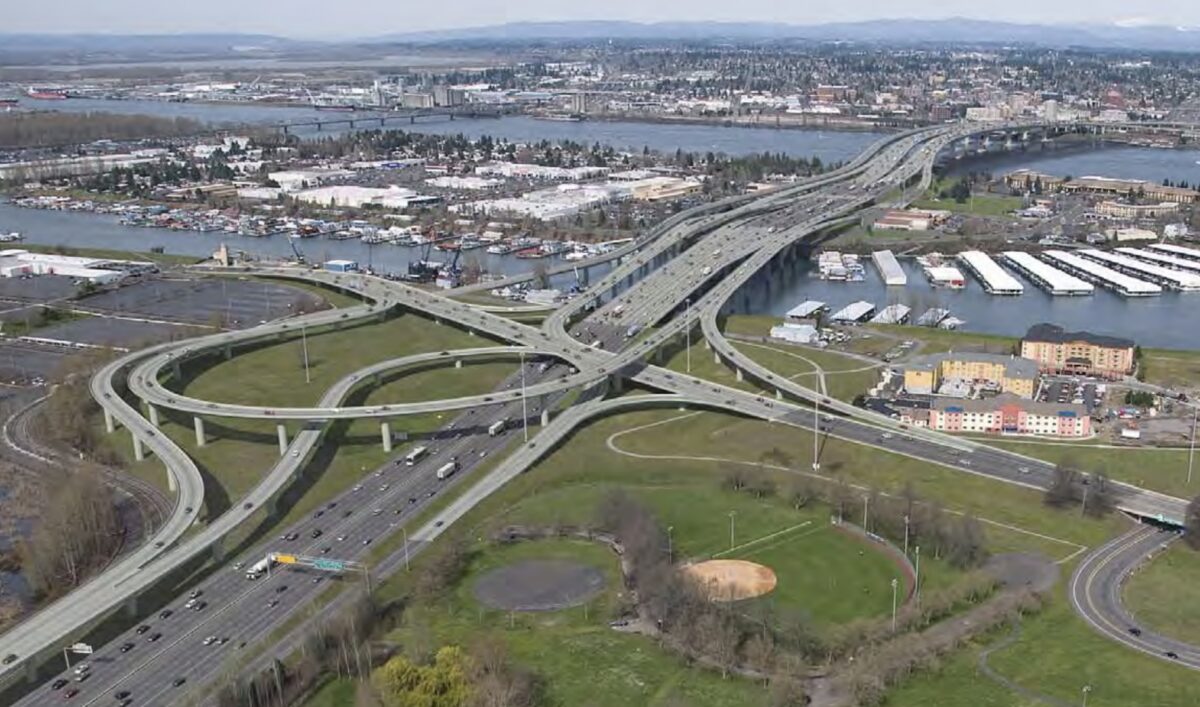
(Note: This is Ryan Packer’s first article for BikePortland. They’ll cover the effort to expand I-5 and replace the Interstate Bridge between Oregon and Washington.)
At the beginning of this year, Program Administrator Greg Johnson said the project team was about to “start running” to achieve the goal of construction by 2025. But hurdles are popping up faster than anticipated.
In 2013, when Oregon’s then-Governor John Kitzhaber issued a public statement to announce the Columbia River Crossing highway expansion project was dead, he pointed the finger at one institution: the Washington State Senate. That year, a $10 billion transportation funding package had failed to pass after squeaking through the Washington State House of Representatives. “I am extremely disappointed that our legislative partners in the Washington state Senate failed to address the clear and present safety and economic need for this essential I-5 bridge.” Despite Oregon’s attempts to go-it-alone after the Washington legislature wouldn’t act, the fact that a deal couldn’t be reached that session was crucial to the project’s demise.
At the beginning of Washington’s legislative session this January, it looked like things had changed. Of numerous proposals for what a transportation package might look like, all of them included a huge earmark for the project. The 2013 allocation of $450 million had essentially doubled to $1 billion. This past Sunday the sun set on the 105-day session and only one chamber’s transportation package had been passed out of committee, much less received a floor vote.
But the CRC zombie refuses to die.
A handful of Washington lawmakers gave other members an incentive to come back to the negotiating table; two of the Democrats’ key pieces of legislation passed this session — a carbon cap-and-trade bill and a low-carbon fuel standard — both require a transportation package of some kind to pass in order to take effect. It’s against this background that the I-5 project is moving forward.
What form it takes — a carbon copy or a new mold — remains to be seen.
Advertisement
Between 2010 and 2020, when the Columbia River Crossing mostly sat dormant, waiting to be revived as the “Interstate Bridge Replacement program” (a misnomer since most the funding would expand five miles of the freeway), Washington and Oregon together gained nearly 1.4 million residents — more people than currently live in ten other states. Yet the question of how much of the environmental review process from that failed endeavor can be reused is the biggest question on the table right now. Attempts to add climate change and equity considerations directly into the project’s all-important “Purpose and Need” statement have been met with hesitation by the project team. Why? Because making those changes may prompt the Federal Highway Administration to consider the project significantly changed from the one it issued a Record of Decision on in 2011, which could trigger more analysis (and delays). On the other hand, if a carbon copy of those Purpose and Need statements are used, it’s likely to push the project closer to the previous — and highly controversial — design.

At a meeting of the project’s Executive Steering Group (made up of elected and agency heads from around the region) this week, some members expressed how much they’d like to avoid a do-over — a.k.a. “path four” in the chart above shared by the project team. The other paths an updated environmental review could take include no re-evaluation or one of two middle paths. Portland Bureau of Transportation Commissioner and ESG member Jo Ann Hardesty, who has already voiced a desire to add climate and equity language to the Purpose and Need, told the group she envisions going down paths two or three which would require a Supplemental EIS (environmental impact statement).
The discussion of Purpose and Need at the ESG is taking place well before any of the other issues that caused the original CRC to fall apart are even on the table, but that hasn’t stopped those issues from resurfacing elsewhere. Elected officials are already going back and forth via the press over the issue of whether the bridge will carry light rail after Rep. Earl Blumenauer told Willamette Week the project won’t happen without it. This prompted a reply from his Republican colleague from across the river, Rep. Jaime Herrera Beutler, who told Clark County Today: “This same stubborn, top-down attitude effectively killed the last I-5 bridge replacement effort.”
A vote to approve the Purpose and Need statements had originally been planned for late May. That vote has now been delayed. At the beginning of this year, Program Administrator Greg Johnson said the project team was about to “start running” to achieve the goal of construction by 2025. But hurdles are popping up faster than anticipated.

— Ryan Packer lives in Seattle and covers transportation issues as a senior editor at The Urbanist. Contact them at ryan@theurbanist.org
— Get our headlines delivered to your inbox.
— Support this independent community media outlet with a one-time contribution or monthly subscription.
